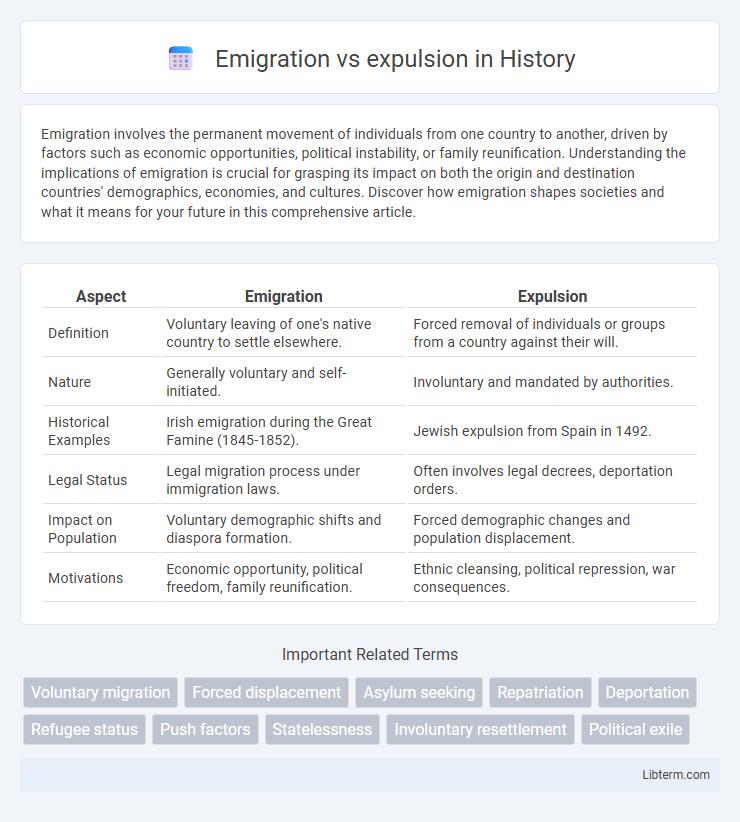Emigration involves the permanent movement of individuals from one country to another, driven by factors such as economic opportunities, political instability, or family reunification. Understanding the implications of emigration is crucial for grasping its impact on both the origin and destination countries' demographics, economies, and cultures. Discover how emigration shapes societies and what it means for your future in this comprehensive article.
Table of Comparison
| Aspect | Emigration | Expulsion |
|---|---|---|
| Definition | Voluntary leaving of one's native country to settle elsewhere. | Forced removal of individuals or groups from a country against their will. |
| Nature | Generally voluntary and self-initiated. | Involuntary and mandated by authorities. |
| Historical Examples | Irish emigration during the Great Famine (1845-1852). | Jewish expulsion from Spain in 1492. |
| Legal Status | Legal migration process under immigration laws. | Often involves legal decrees, deportation orders. |
| Impact on Population | Voluntary demographic shifts and diaspora formation. | Forced demographic changes and population displacement. |
| Motivations | Economic opportunity, political freedom, family reunification. | Ethnic cleansing, political repression, war consequences. |
Understanding Emigration: Voluntary Departure Explained
Emigration refers to the voluntary act of leaving one's country to settle permanently in another, driven by factors such as economic opportunities, education, or personal reasons. Unlike expulsion, which involves forced removal by a government or authority, emigration is a personal decision made freely by the individual. Understanding emigration involves recognizing it as a planned transition motivated by aspirations for a better quality of life or new experiences abroad.
Defining Expulsion: Forced Removal from a Country
Expulsion refers to the involuntary removal of individuals or groups from a country, typically enforced by governmental authorities due to legal, political, or security reasons. Unlike emigration, which is a voluntary departure from a country to settle elsewhere, expulsion involves coercion and is often linked to deportation orders, exile, or forced migration due to conflict or human rights violations. Key legal frameworks regulating expulsion include international human rights law and refugee protection protocols aimed at preventing arbitrary or unjust forced removals.
Key Differences Between Emigration and Expulsion
Emigration refers to the voluntary act of leaving one's country to settle permanently in another, driven by factors like seeking better opportunities or family reunification. Expulsion involves the forced removal or deportation of individuals from a country due to legal, political, or security reasons, often without their consent. Key differences include the element of choice, with emigration being voluntary and expulsion involuntary, alongside contrasting legal frameworks and implications on personal rights.
Historical Contexts of Emigration and Expulsion
Historical contexts of emigration often involve voluntary movement driven by economic opportunities, political freedoms, or religious asylum, as seen during the 19th-century European migrations to the Americas. By contrast, expulsion refers to forced removals, frequently occurring in times of conflict or ethnic cleansing, exemplified by the Armenian expulsion during World War I or the Jewish expulsions from medieval Europe. These differing circumstances underline the complex socio-political dynamics shaping population movements throughout history.
Legal Perspectives: Rights of Emigrants vs. Expelled Persons
Legal perspectives distinguish emigrants, who voluntarily leave their country, from expelled persons, who are forced to leave due to government action or legal mandates. Emigrants retain full rights to re-enter their home country and often benefit from protections under international law such as the right to nationality. Expelled persons face restrictions on return and may lose certain civil rights, with expulsion often justified by national security or immigration control statutes.
Common Causes Behind Emigration and Expulsion
Emigration often results from economic hardship, political instability, or the pursuit of better opportunities, prompting individuals to leave their home countries voluntarily. Expulsion is typically driven by legal or political actions, such as violations of immigration laws, security concerns, or government policies targeting specific groups. Both processes reflect underlying social, economic, and political pressures, though emigration is self-initiated, while expulsion is enforced by authorities.
Societal Impact: Effects on Individuals and Communities
Emigration often reflects voluntary movement driven by economic opportunities or personal aspirations, enabling individuals to seek improved living conditions while contributing to cultural diversity and economic growth in host communities. Expulsion, marked by forced displacement due to political, ethnic, or social conflicts, generates trauma, disrupts social cohesion, and burdens both displaced individuals and receiving areas with sudden demographic shifts. Both phenomena reshape community structures, influence labor markets, and impact social services, often prompting complex humanitarian and policy challenges.
Case Studies: Notable Examples Worldwide
Case studies on emigration versus expulsion reveal distinct global patterns, such as the Palestinian exodus following the 1948 Arab-Israeli conflict, illustrating forced displacement under expulsion. In contrast, the voluntary migration of Indian professionals to the United States during the early 2000s exemplifies emigration driven by economic opportunity. These examples highlight how political, social, and economic factors influence population movements differently across contexts.
Humanitarian Challenges in Emigration and Expulsion
Emigration and expulsion present distinct humanitarian challenges, where emigration is often driven by individuals seeking safety, better living conditions, or economic opportunities, while expulsion involves forced removal by authorities, frequently violating human rights. Emigrants face obstacles such as legal barriers, discrimination, and lack of access to services, whereas expelled populations endure abrupt displacement, loss of property, and psychological trauma. Both phenomena require comprehensive international protection frameworks and coordinated humanitarian responses to address the vulnerabilities of affected individuals and uphold human dignity.
Policy Approaches: Managing Emigration and Preventing Expulsion
Policy approaches to managing emigration emphasize creating economic opportunities and improving living conditions to encourage voluntary migration, while preventing expulsion involves strict border controls and legal frameworks to safeguard human rights. Governments implement bilateral agreements and international cooperation to facilitate safe migration pathways and reduce forced displacements. Effective strategies balance national security concerns with humanitarian obligations to ensure orderly and ethical population movements.
Emigration Infographic

 libterm.com
libterm.com